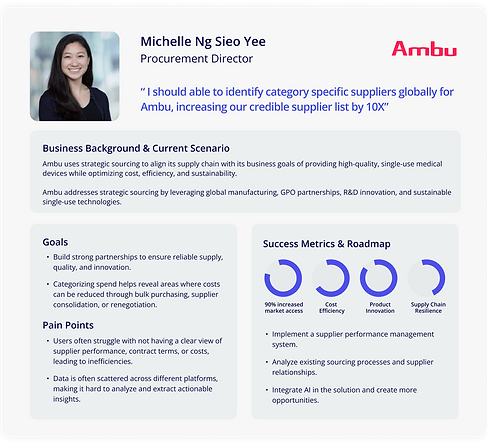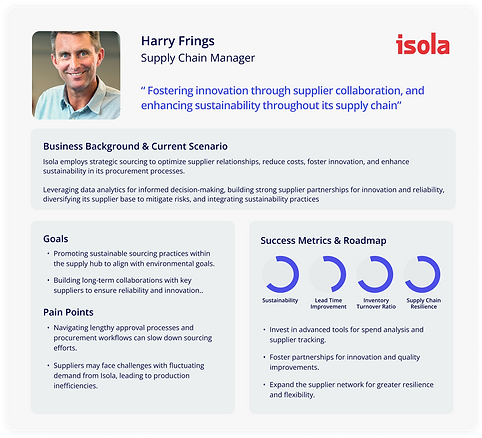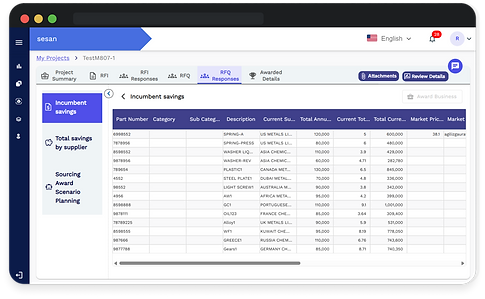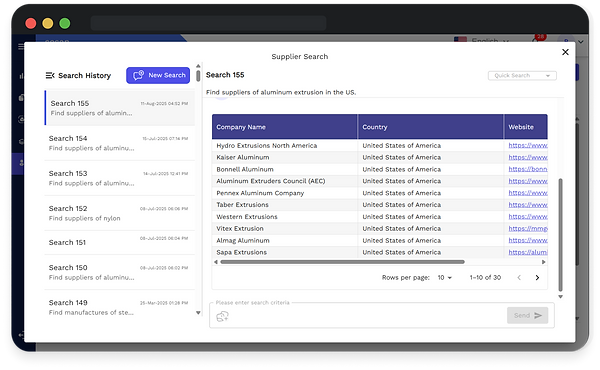
AI-powered platform revolutionizing supplier discovery and strategic sourcing—delivering speed, efficiency, and superior results!
S
U
P
P
L
Y
H
U
B
Spend Management for buyer & supplier
Web Application
Duration: 4 Weeks
Story
The need for a better sourcing solution was further reinforced by the fact that even though over 80% of supply chain spend is addressed during sourcing, over $1.1 Trillion* of this spend was not being optimized.
Additionally, gen AI platforms that are highly suitable for making sense out of large quantities of unstructured data became widely available around the end of 2022, making the timing impeccable to build a transformative sourcing solution.
My Role
As a User Experience Designer, my goal is to simplify the workflow of buyer and supplier making the platform efficient, reduce cognitive load, improve information discovery, reduce clutter's and improve overall performance.
I contributed directly with stakeholders understanding their customer journey and needs and collaborating with UX designers, product manager, engineers to improve workflow and ensuring consistency in automation.
The Challenge
Designing systems for strategic sourcing using unstructured data presents several challenges, but specifically 4 problem areas identified for MVP which are:
👉 Spend Categorization:
Transforming unclassified spend into strategic categories for sourcing and savings analyzing from multiple sources resulting over 100 times faster than traditional methods.
👉 Savings Identification:
Quickly analyze your company’s costs and supply market trends to uncover savings at the category level. Seamlessly craft a sourcing strategy that optimizes the balance between size cost reduction and ease of implementation, significantly enhancing value creation!
👉 Supplier Discovery:
Identify suppliers across industries and target regions worldwide, focusing on specific categories. Create a curated list of suppliers that are well matched to provide necessary parts or services, ensuring precision and speed in your sourcing efforts!
👉 Sourcing Co-Pilot:
Transform your sourcing with an automated system that speeds up and simplifies the request for quotation (RFQ) process, analyzes bids, and develops award scenarios.
The Approach
AI leveraged design process
I used design thinking process and AI as user centered approach while understanding the context, data and user feedback.

Empathizing & Gathering data
👉 Stakeholder Interview
👉 Framing Context
👉 Data Insights
👉 Validate with User Feedback
Define the Problem & Ideate
👉 Affine patterns on user statements
👉 Competitive Analysis
👉 Journey Mapping
👉 HMW framework - to unlock ideas
👉 User Flow
Design Outcomes & Validation
👉 Sketching & Wire-framing
👉 Scalable Design System
👉 UI Mock & Prototype
👉 Design Impact

Discovery & Findings
Understanding the problem and user needs
Conducted primary research (stakeholder interview) to understand the strategic sourcing and their end customers needs and key observations in regions

2 Stakeholder Interview

10 Qualitative Questions

2 End Customers

3 Focus Regions
Sample Questions
1. What are the biggest challenges you face in spend categorization?
2. How do you currently discover and onboard new suppliers?
3. What are the common bottlenecks in procurement workflows?
4. How do inefficiencies in procurement impact overall business performance?
5. What features would you expect from an AI-driven spend categorization or supplier discovery tool?
Goals
Identify Pain Points in Procurement Workflows
Evaluate the Role of AI in Optimizing Procurement
Enhance User Experience for Procurement Teams
Stakeholders from SupplyHub | End Users - Ambu (medical supplies case) & Isola (Electronic materials case)
Regional Observations
USA - More advanced spend analytics tools, but teams struggle with integration across ERP systems.
Focus on cost optimization and compliance with federal regulations (e.g., SOX).
China - High supplier fragmentation, leading to inconsistent data categorization.
Procurement is often relationship-driven (Guanxi) rather than structured, making AI adoption slower.
Germany - Strict financial reporting laws (IFRS & EU compliance) require precise spend classification.
Procurement teams focus on long-term supplier partnerships rather than cost-cutting.
Secondary Research evidence
Finding 1
Inconsistent Spend Categorization (75% struggle with misclassification)
Insight: 75% of procurement teams struggle with spend misclassification due to fragmented data and manual entry errors.
Problem: Poor financial visibility, inaccurate budgeting, and missed cost-saving opportunities.
Solution: Introducing an AI-powered spend categorization system with automated classification based on template could be validated.
Finding 2
Slow Supplier Discovery (4-8 weeks delay, 60% use outdated vendors)
Insight: Supplier sourcing takes 4-8 weeks, and 60% of buyers rely on outdated vendor lists.
Problem: Delayed procurement cycles, limited cost optimization, and reduced supplier diversity.
Solution: Implemented an AI-driven supplier recommendation engine based on industry, region, with filters for compliance—reducing sourcing time significantly.
Finding 3
High Dependency on Manual Workflows which take more effort.
Insight: 80% of procurement teams still use spreadsheets, causing inefficiencies and errors.
Problem: Increased operational workload, lack of real-time insights, and slow decision-making.
Solution: An interactive dashboard with automation capabilities, real-time data visualization, and seamless ERP integration to reduce manual effort
Competitive Analysis
Evaluation on features, platform comparison, differentiator and analysis on how SupplyHub can be positioned in market.


Affinity Associations
This is a collaborative approach to defining patterns by collecting statements from stakeholders during the workshop and organizing them into categories, which ultimately leads to key insights.
Concerns
Huge excel sheets user goes manually for direct and indirect type of spend
How to identify unclassified spend and categorize with supplier details
Opportunities
Gen AI to cater 3 use cases - spend categorization, supplier discovery, analyzes bids and develop scenarios.
AI helps identify and categorize unclassified spend with supplier details.
KPI's
Procurement ROI measures the cost-effectiveness and profitability of the procurement organization. It's calculated by dividing the annual cost savings by the annual procurement cost.
Spend under management measures how well a company manages its spend, including established rates with suppliers and control systems to ensure negotiated prices are used.
Breaks down spending into various categories, such as direct and indirect spend, to provide insights into where money is being allocated.
Gaps
Manual Spend Analysis – Users rely on large Excel sheets to track direct and indirect spending.
Lack of Spend Categorization – Difficulty in identifying unclassified spend and associating it with suppliers.
Drawbacks or Issues
No Standardized Spend Templates – Direct and indirect spend templates are not integrated into metadata, leading to inefficiencies.
Slow Sourcing Process – Lack of automation slows down the procurement and sourcing cycle.
Data Utilization – Companies struggle to use past spending data efficiently for better supplier negotiations and cost management.
Complexity in Bid Analysis – Mapping business scenarios, analyzing supplier bids, and planning awards require extensive manual effort.

Reframed Problem Statement
“To enhance the sourcing experience for procurement professionals, we should create an intuitive, data-driven platform that streamlines supplier evaluation and collaboration. Integrating AI will automate tasks, provide predictive analytics, and enable smarter sourcing strategies, ultimately reducing costs and increasing convenience.”
Deep Dive
Optimizing spend through categorization maximizing value in procurement
Category spend analysis is a systematic and in-depth examination of an organization’s spending across various procurement categories. It involves gathering, categorizing, and analyzing procurement data to gain insights into how and where money is being spent. By breaking down spending patterns and understanding the underlying factors influencing expenditures, category spend analysis provides a comprehensive overview of an organization’s procurement landscape.

Supplier Discovery with AI - Increasing value in procurement
In procurement, the need to understand internal spend; for more robust processes, and to manage compliance, accurate spend data is foundational for effective spend management strategies.
Based on several AI techniques, spend classification algorithms dynamically search through line item details and flag keywords to tie to spend categories. Those that use AI spend classification have typically achieved 97% accuracy in classification data, increasing precision and driving value
Insights gathered from Persona
This process highlights key motivations and preferences, enabling better marketing strategies and improved customer engagement.



Taskflow of buyers and suppliers
Journey Stages & Experience Mapping
This process highlights key motivations and preferences, enabling better marketing strategies and improved customer engagement.
.png)
'HMW' framework to unlock ideas
During this design phase, pinpointing solution ideas based on 'must have', 'should have', and 'good to have' criteria can define MVP features that align with business objectives.
Driving Question 1
HMW help procurement teams transform raw, unclassified spend data into actionable categories without relying on manual Excel work?
Idea (Design Approach)
AI-powered categorization engine with confidence scores + analyst override loop
Design Outcomes (Possible Impact)
Users felt less burdened by manual work and more confident validating AI-driven categories
Driving Question 2
HMW enable procurement teams to discover and evaluate suppliers across regions transparently and efficiently?
Idea (Design Approach)
AI-driven supplier matching with regional filters adding supplier comparison tables with explainable scoring
Design Outcomes (Possible Impact)
Users felt empowered to expand beyond known suppliers and make fairer, transparent comparisons
Driving Question 3
HMW uncover and prioritize savings opportunities in a way that balances business impact, feasibility, and ease of execution?
Idea (Design Approach)
Savings cards ranked by shortlisted RFQ bids, annual spend impact, and market price gaps → tagged as “Quick Wins” or “Strategic Bets”
Design Outcomes (Possible Impact)
Procurement teams could clearly see where to act first, leading to more confident and focused decision-making
Driving Question 4
HMW streamline RFQ creation and award decisions while keeping the process explainable and auditable?
Idea (Design Approach)
Sourcing co-pilot that drafts requests, ranks bids, and simulates award scenarios with “why this recommendation” explanations
Design Outcomes (Possible Impact)
Teams felt the RFQ process was faster, easier to manage, and more transparent without losing control for both buyer and supplier.
Ideation Sketches & Wireframes
Design System
Color Tokens
Medium Persian Blue
#504FE9
Slate Blue
#40408B
Cetacean Blue
#060641
SupplyHub Blue (primary) to be used to be as main colour theme across application like action buttons, emphasis, uniformity
Red
#BD4334
Yellow
#F2BE42
Ocean Blue
#267F98
Green
#338037
Blue
#4072CB
SupplyHub Variants (supportive) to be used complementing primary colours like status, dialogue box icons. Best to use in a minimal way possible.
Light Grey
#D9D9D9
Dark Grey
#767676
SupplyHub Grey to be used as surface / background colour to tone down the balance of colours.
Typography
ABCDEFGHIJKLMNOPQRSTUVWXYZ
abcdefghijklmnopqrstuvxyz
1234567890!@#

Executive Dashboard
To show data driven analytical view of spend of suppliers on different categories.
on hover chart details




My Projects
Ability to create projects based on RFI & RFQ workflows

RFI Responses -
Shortlisted supplier score summary

Awarded Details -
Annual supplier spend and savings

RFQ Responses -
Round bidding for supplier selection

Incumbent Savings -
Total current savings with market differentiation
Spendcube
Direct and indirect spend refer to different categories of business expenses. Understanding this distinction is crucial for effective budgeting and cost management.


Metadata -
Data structure of spend type based on region

Analytics -
Data analysis of the fields of spendcube

Spend Categorization
AI classify and organize spending data of an organization into pre-defined categories.It analyze various data sources and accurately categorize expenses based on pre-defined taxonomies or custom rules.
Supplier Discovery
By analyzing various sources AI discovers potential supplier details matching with categories, region, industry, product and service.


Impact
40%
Spend categorization automation accuracy improved with AI
4X
Expansion of the pool of suppliers including diverse and regional suppliers with AI integrations
Design Impact
-
RFQ Co-pilot: Cut RFQ cycle time from 5 days → <24 hours with AI-assisted workflows.
-
Savings Identification: Helped analysts uncover 3× more cost-saving opportunities per cycle.
-
Workflow Efficiency: Improved procurement team satisfaction from 3.1 → 4.6/5 through streamlined flows.
Business Impact
-
VC Funding: Investors said, “Clear, market-ready vision,” helping secure funding.
-
Efficiency: Clients noted, “We identify savings and suppliers much faster.”
-
Market Readiness: Investors highlighted strong differentiation and growth potential.

Reflection & Learnings
This project demonstrated the impact of AI-driven UX solutions on high-value user problems. Through the design process—research, prototyping, and validation—I learned the importance of aligning design with user needs and business goals. Cross-region research highlighted localization and supplier diversity, while iterative testing reinforced the value of continuous feedback. Future improvements include earlier supplier involvement, expanded predictive AI insights, and AI agent integration to further enhance efficiency and business impact, including securing venture capital funding.
Next Steps
-
Involve suppliers earlier in testing to capture negotiation-specific requirements.
-
Expand predictive sourcing insights for proactive cost-saving opportunities.
-
Integrate AI agents to automate tasks like spend prediction and RFQ suggestions.
-
Connect with ERP systems and advanced analytics dashboards for deeper operational insights.
-
Implement continuous user feedback loops to refine AI recommendations post-launch.




